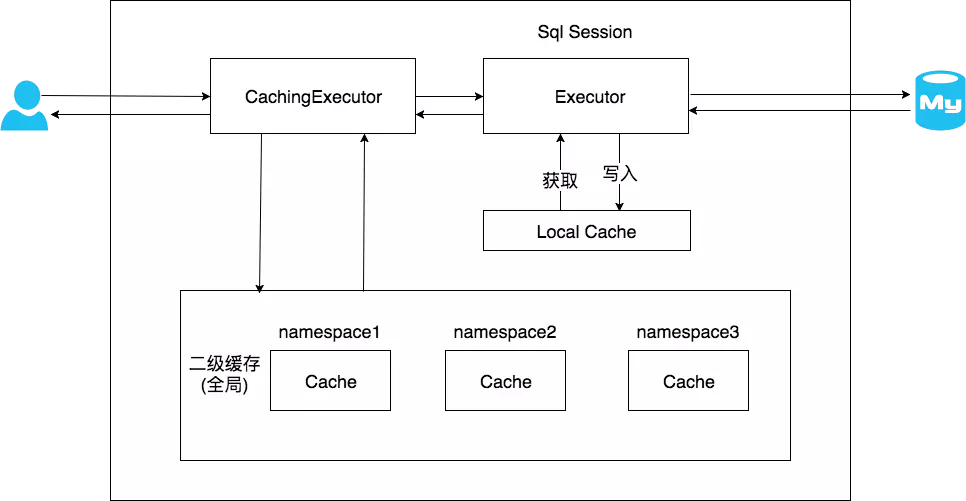二级缓存介绍
在上文中提到的一级缓存中,其最大的共享范围就是一个SqlSession内部,那么如何让多个SqlSession之间也可以共享缓存呢,答案是二级缓存。
当开启二级缓存后,会使用CachingExecutor装饰Executor,在进入后续执行前,先在CachingExecutor进行二级缓存的查询,具体的工作流程如下所示。

在二级缓存的使用中,一个namespace下的所有操作语句,都影响着同一个Cache,即二级缓存是被多个SqlSession共享着的,是一个全局的变量。
当开启缓存后,数据的查询执行的流程就是 二级缓存 -> 一级缓存 -> 数据库。
二级缓存配置
要正确的使用二级缓存,需完成如下配置的。
1 在Mybatis的配置文件中开启二级缓存。
<setting name="cacheEnabled" value="true"/>
2 在Mybatis的映射XML中配置cache或者 cache-ref 。
<cache/>
<cache-ref namespace="mapper.StudentMapper"/>
cache-ref代表引用别的命名空间的Cache配置,两个命名空间的操作使用的是同一个Cache。
二级缓存实验
实验1
测试二级缓存效果,不提交事务,sqlSession1查询完数据后,sqlSession2相同的查询是否会从缓存中获取数据。
@Test
public void testCacheWithoutCommitOrClose() throws Exception {
SqlSession sqlSession1 = factory.openSession(true);
SqlSession sqlSession2 = factory.openSession(true);
StudentMapper studentMapper = sqlSession1.getMapper(StudentMapper.class);
StudentMapper studentMapper2 = sqlSession2.getMapper(StudentMapper.class);
System.out.println("studentMapper读取数据: " + studentMapper.getStudentById(1));
System.out.println("studentMapper2读取数据: " + studentMapper2.getStudentById(1));
}
执行结果:
我们可以看到,当sqlsession没有调用commit()方法时,二级缓存并没有起到作用。
实验2
测试二级缓存效果,当提交事务时,sqlSession1查询完数据后,sqlSession2相同的查询是否会从缓存中获取数据。
@Test
public void testCacheWithCommitOrClose() throws Exception {
SqlSession sqlSession1 = factory.openSession(true);
SqlSession sqlSession2 = factory.openSession(true);
StudentMapper studentMapper = sqlSession1.getMapper(StudentMapper.class);
StudentMapper studentMapper2 = sqlSession2.getMapper(StudentMapper.class);
System.out.println("studentMapper读取数据: " + studentMapper.getStudentById(1));
sqlSession1.commit();
System.out.println("studentMapper2读取数据: " + studentMapper2.getStudentById(1));
}
从图上可知,sqlsession2的查询,使用了缓存,缓存的命中率是0.5。
实验3
测试update操作是否会刷新该namespace下的二级缓存。
@Test
public void testCacheWithUpdate() throws Exception {
SqlSession sqlSession1 = factory.openSession(true);
SqlSession sqlSession2 = factory.openSession(true);
SqlSession sqlSession3 = factory.openSession(true);
StudentMapper studentMapper = sqlSession1.getMapper(StudentMapper.class);
StudentMapper studentMapper2 = sqlSession2.getMapper(StudentMapper.class);
StudentMapper studentMapper3 = sqlSession3.getMapper(StudentMapper.class);
System.out.println("studentMapper读取数据: " + studentMapper.getStudentById(1));
sqlSession1.commit();
System.out.println("studentMapper2读取数据: " + studentMapper2.getStudentById(1));
studentMapper3.updateStudentName("方方",1);
sqlSession3.commit();
System.out.println("studentMapper2读取数据: " + studentMapper2.getStudentById(1));
}
我们可以看到,在sqlSession3更新数据库,并提交事务后,sqlsession2的StudentMapper namespace下的查询走了数据库,没有走Cache。
实验4
验证Mybatis的二级缓存不适应用于映射文件中存在多表查询的情况。一般来说,我们会为每一个单表创建一个单独的映射文件,如果存在涉及多个表的查询的话,由于Mybatis的二级缓存是基于namespace的,多表查询语句所在的namspace无法感应到其他namespace中的语句对多表查询中涉及的表进行了修改,引发脏数据问题。
@Test
public void testCacheWithDiffererntNamespace() throws Exception {
SqlSession sqlSession1 = factory.openSession(true);
SqlSession sqlSession2 = factory.openSession(true);
SqlSession sqlSession3 = factory.openSession(true);
StudentMapper studentMapper = sqlSession1.getMapper(StudentMapper.class);
StudentMapper studentMapper2 = sqlSession2.getMapper(StudentMapper.class);
ClassMapper classMapper = sqlSession3.getMapper(ClassMapper.class);
System.out.println("studentMapper读取数据: " + studentMapper.getStudentByIdWithClassInfo(1));
sqlSession1.close();
System.out.println("studentMapper2读取数据: " + studentMapper2.getStudentByIdWithClassInfo(1));
classMapper.updateClassName("特色一班",1);
sqlSession3.commit();
System.out.println("studentMapper2读取数据: " + studentMapper2.getStudentByIdWithClassInfo(1));
}
执行结果:
在这个实验中,我们引入了两张新的表,一张class,一张classroom。class中保存了班级的id和班级名,classroom中保存了班级id和学生id。我们在StudentMapper中增加了一个查询方法getStudentByIdWithClassInfo,用于查询学生所在的班级,涉及到多表查询。在ClassMapper中添加了updateClassName,根据班级id更新班级名的操作。当sqlsession1的studentmapper查询数据后,二级缓存生效。保存在StudentMapper的namespace下的cache中。当sqlSession3的classMapper的updateClassName方法对class表进行更新时,updateClassName不属于StudentMapper的namespace,所以StudentMapper下的cache没有感应到变化,没有刷新缓存。当StudentMapper中同样的查询再次发起时,从缓存中读取了脏数据。
实验5
为了解决实验4的问题呢,可以使用Cache ref,让ClassMapper引用StudenMapper命名空间,这样两个映射文件对应的Sql操作都使用的是同一块缓存了。
执行结果:
不过这样做的后果是,缓存的粒度变粗了,多个Mapper namespace下的所有操作都会对缓存使用造成影响,其实这个缓存存在的意义已经不大了。
总结
- Mybatis的二级缓存相对于一级缓存来说,实现了SqlSession之间缓存数据的共享,同时粒度更加的细,能够到Mapper级别,通过Cache接口实现类不同的组合,对Cache的可控性也更强。
- Mybatis在多表查询时,极大可能会出现脏数据,有设计上的缺陷,安全使用的条件比较苛刻。
- 在分布式环境下,由于默认的Mybatis Cache实现都是基于本地的,分布式环境下必然会出现读取到脏数据,需要使用集中式缓存将Mybatis的Cache接口实现,有一定的开发成本,不如直接用Redis,Memcache实现业务上的缓存就好了
- 最终的结论是Mybatis的缓存机制设计的不是很完善,在使用上容易引起脏数据问题,个人建议不要使用Mybatis缓存,在业务层面上使用其他机制实现需要的缓存功能,让Mybatis老老实实做它的ORM框架就好了。